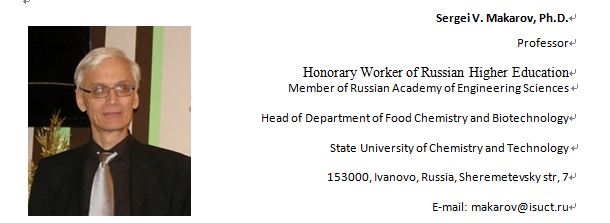题目:Reactivity of Thiourea Dioxide
报告人:Prof. Sergei V. Makarov
时间:10月25日下午15:00
地点:18号楼218室
个人简介:

S. V. Makarov graduated from ISUCT in 1978 (Electrochemistry, Diploma with Honours), earned Ph.D. in 1986, and Doctor of Sciences degree in Physical Chemistry in 2000, from Ivanovo State University of Chemistry and Technology. Makarov's research interests focus on chemistry and application of sulfur-containing reductants, including sodium dithionite, rongalite and thiourea dioxide, reduction of dyes, food chemistry, as well as chemistry of vitamin B12, phthalocyanines and homogeneous catalysis. Makarov has received 5 grants from Russian Foundation for Basic Research, 3 grants from DAAD and 2 grants from Russian Ministry of Education. He has published two books, two book chapters, three reviews and more than 130 other peer-reviewed journal articles. Makarov has also delivered over 90 presentations at international and national conferences. He has translated 5 books on organic and food chemistry from English into Russian. He has been working in USA, China, Germany, Romania, Austria and many other countries. He is a member of Editorial Board of Journal of Coordination Chemistry as well as Editorial Boards of two Russian Chemical Journals.
Abstract
Sodium dithionite, sodium hydroxymethanesulfinate (rongalite) and thiourea dioxide have long been used in chemistry, chemical technology and textile industry as reductants. Recently some new fields of their application have been developed: reduction of graphene and graphite oxides, synthesis of metal sulfides and nanometer metal powders, metallization of fibres, organic synthesis including organocatalytic reactions, nonlinear phenomena in chemical kinetics. Many new relatives of these compounds have been synthesized.
Though using dithionite, hydroxymethanesulfinate and thiourea dioxide as strong reducing agents remains the main field of their application, other importan--t trends should also be highlighted. For example, in contrast to the redox reactions in which the sulfur-containing part of thiourea dioxide plays the governing role, it is the nitrogen part of thiourea dioxide that determines their reactivity in the synthesis of guanidines and its derivatives. And, of course, thiourea dioxide deserves a special attention as it can be considered as intermediate of the oxidation of thiourea. Different thioureas are now among the main environmental friendly organocatalysts.
This talk will be devoted to the main aspects of reactivity and application of thiourea dioxide.
组织单位:生态染整技术教育部工程研究中心
材料与纺织学院、丝绸学院
先进纺织材料与制备技术教育部重点实验室